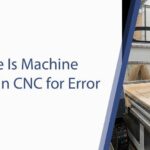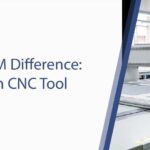IoT Connectivity in CNC Machines: The Future of Smart Manufacturing
The Internet of Things (IoT) is one of the technologies that transforms manufacturing processes and enhances efficiency.
In particular, IoT integration in CNC machines makes factories more efficient, flexible, and intelligent.
This technology connects machines, enabling data collection, analysis, optimization of processing parameters, and improvement of production processes.
This article will thoroughly explore IoT in CNC machines, its advantages, and its role in the future.

Contributions of IoT to CNC Machines: Industrial and Academic Perspectives
- Real-Time Data Collection and Monitoring: Data-Driven Manufacturing The integration of IoT in CNC machines provides real-time data collection and monitoring, allowing for high efficiency and quality at every stage of the manufacturing process. CNC machines are typically equipped with sensors that monitor processing parameters (such as spindle speed, cutting forces, tool wear, and temperature). These sensors continuously collect data, which is transmitted to cloud-based platforms. As a result, machine performance is optimized, breakdowns are detected early, and production interruptions are prevented.
From an academic perspective, IoT’s data collection and analysis processes allow continuous monitoring of parameters that were previously difficult to measure manually.
This improves the accuracy of manufacturing processes and leads to more consistent results.
Properly processed data, combined with machine learning and artificial intelligence algorithms, helps develop more efficient production strategies.
- Predictive Maintenance and Reduced Downtime: Proactive Management Another important IoT application is predictive maintenance systems. Traditional maintenance methods wait for machines to break down before intervening, whereas IoT-enabled systems continuously monitor the health of machines. Sensors track factors such as vibration, temperature, lubrication levels, and motor performance. These data are processed through analytical software, detecting potential risks of failure.
In the industrial field, predictive maintenance helps reduce costs, minimize production losses, and extend the lifespan of machines.
Academic studies show that IoT-based predictive maintenance systems can reduce production errors by 20-30% and significantly lower maintenance costs.
Furthermore, these systems increase operational continuity by predicting and resolving production issues in advance.
- Remote Access and Smart Control: Dynamic Production Management With IoT, CNC machines can be monitored and controlled remotely via smartphones, tablets, or computers. This provides factory managers and operators with real-time access to production processes, allowing them to adjust parameters and troubleshoot issues. Additionally, remote access allows for faster and more efficient maintenance and improvement tasks without the need for on-site intervention.
From an academic perspective, this remote access feature offers flexibility and control over production processes.
Particularly in large-scale factories, the tools provided by IoT for central management and optimization help improve operational efficiency and foster the development of more effective production strategies.
Remote access allows operators to monitor processes and intervene quickly, even if they are not physically at the machine.
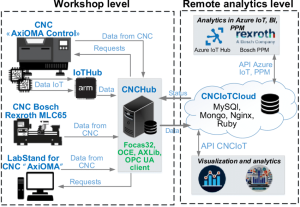
- Digital Twin Technology: Virtual Production Environments Digital twins are virtual models of real-world CNC machines. IoT enables the creation of these digital twins. Real-time data is transferred to the digital twin, where simulations can be performed. These tests help experiment with new machining strategies, simulate production processes, and detect potential issues in advance.
Academically, digital twin technology is a powerful tool for understanding and optimizing the operation of physical machines.
The combination of IoT and digital twins enables manufacturers to simulate potential scenarios and test production processes in a virtual environment.
This process not only reduces error rates but also creates significant opportunities for developing new machining methods and improving existing strategies.
- Energy Efficiency and Sustainable Production: Environmentally Friendly Solutions Another significant contribution of IoT is energy efficiency. IoT-based analytical systems monitor energy consumption in CNC machines and identify unnecessary energy usage. This is achieved by automatically optimizing motor speeds, controlling cooling systems, and minimizing power consumption. As a result, both operating costs are reduced, and environmental sustainability is ensured.
In an industrial context, energy efficiency not only reduces costs but also contributes to creating environmentally friendly production processes.
Academic studies show that energy management systems provide significant benefits in terms of production efficiency and environmental sustainability, and that IoT integration accelerates this process.
The Future of IoT: Integration with Artificial Intelligence, 5G, and Industry 4.0
- Integration of Artificial Intelligence and IoTThe future of IoT will be further strengthened by the integration of artificial intelligence (AI), 5G connectivity, and edge computing technologies. AI-powered IoT systems will not only collect data but also optimize processing parameters in real-time, further enhancing efficiency.
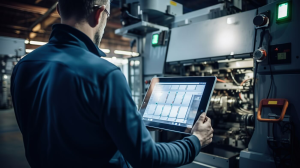
- Fast Data Transmission with 5G Connectivity5G connectivity will provide ultra-fast data transmission, accelerating communication between machines and making remote monitoring and automation more effective.

- Smart Factories and Industry 4.0From an academic standpoint, the combination of these technologies will take the concept of “smart factories” even further. Smart factories, with IoT-enabled systems, will accelerate data sharing between machines, enabling faster, more flexible, and efficient manufacturing processes. This integration, as part of Industry 4.0, will make production processes more dynamic, scalable, and predictable, minimize human intervention, and enhance automation.
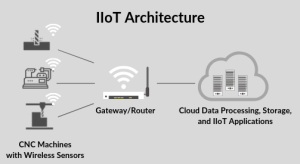
Conclusion: Toward Smart Manufacturing with IoT
- Increased Efficiency and QualityThe integration of IoT into CNC machines is revolutionizing industrial manufacturing. IoT applications such as real-time data collection, predictive maintenance, digital twin technology, and energy efficiency make machines smarter, more efficient, and more cost-effective.
- Industrial Transformation and DigitalizationFrom both academic and industrial perspectives, the advantages provided by IoT in CNC machines ensure that manufacturing processes become more efficient, flexible, and sustainable. As technology evolves, IoT-enabled CNC machines will solidify their position as key components of the digital transformation in the industrial manufacturing world.
Contact Us:
- E-Mail: info@radonix.com
- Phone: +90 (553) 920 5500




